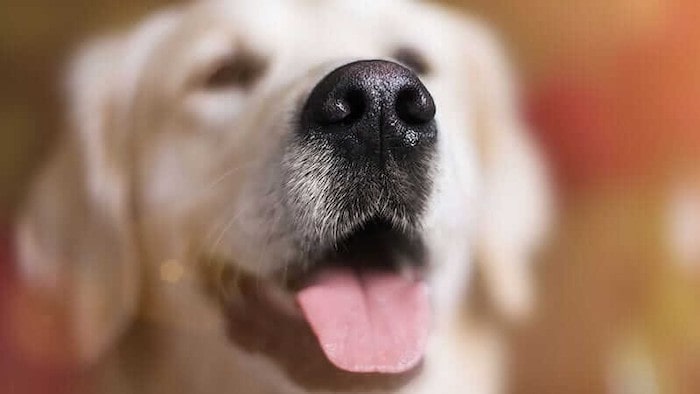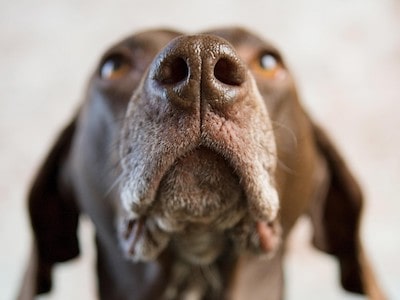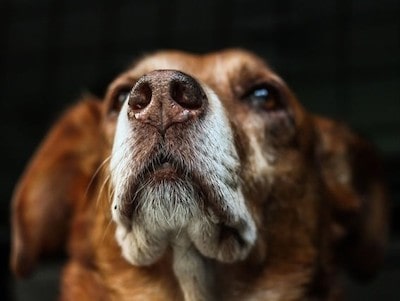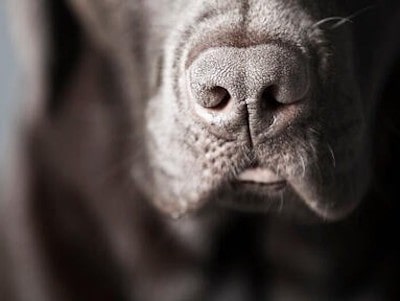Have you ever wondered why your furry companion’s nose is always moist? If you’re a dog owner, you’ve probably noticed that your canine friend’s snout is typically damp, and you might be curious about the reason behind this peculiar characteristic. Don’t worry; you’re not alone! The question of why dogs’ noses are wet has intrigued pet parents, researchers, and animal enthusiasts for generations.
In this blog article, we’ll delve into the fascinating world of canine noses and explore the science behind why they stay moist. From the evolutionary advantage to its role in communication and even potential health implications, there’s much more to a dog’s wet nose than meets the eye.
So, if you’re ready to gain a deeper understanding of this endearing quirk, grab a treat for your furry companion, settle in, and let’s embark on this sniff-tastic journey together!
How Dogs use Their Noses to Smell and Communicate
The first thing to know is that dogs have a much larger and more complex olfactory system than humans. Their nasal cavity is divided into two parts: the respiratory region, which is used for breathing, and the olfactory region, which is used for smelling. The olfactory region occupies about one-third of the nasal cavity in dogs, compared to only 5% in humans.
Dogs also have more than 100 million sensory receptor sites in the nasal cavity, compared to 6 million in people. These receptors are specialized cells that detect different types of odor molecules and send signals to the brain. The brain then interprets these signals and identifies the source and meaning of the smell.
Moreover, the area of the canine brain devoted to analyzing odors is about 40 times larger than the comparable part of the human brain. This means that dogs can process more information from smells and remember them better than humans.

“The dog’s sense of smell is so adept that a blind dog has much less difficulty adjusting to the loss of vision than a human does” says, Ryan Llera, DVM, VCA Hospitals.
But that’s not all. Dogs also have an additional olfactory tool called Jacobsen’s organ, which is located inside the nasal cavity and opens into the roof of the mouth behind the upper incisors. This amazing organ serves as a secondary olfactory system designed specifically for chemical communication.
Jacobsen’s organ can detect pheromones, which are chemical substances that convey information about the sex, age, health, and emotional state of other animals. Pheromones are also used to mark territory and signal reproductive readiness. When dogs sniff each other’s genitals or urine, they are using Jacobsen’s organ to gather information about each other.
Dogs use their sense of smell for various purposes, depending on their breed, personality, and environment. Some dogs use their noses to hunt prey, track missing people or animals, or detect bombs or drugs. Other dogs use their noses to find food, toys, or their owners. And some dogs just use their noses to explore and have fun.
The Science Behind a Wet Nose: How do Dogs Use Their Noses to Smell, Regulate Temperature, and Communicate?
A dog’s nose is composed of two main parts: the external part that we see and touch, and the internal part that contains the olfactory region. The external part consists of two nostrils that can move independently to direct airflow and sniff different scents.
The nostrils are covered by a thin layer of skin that contains special glands that produce mucus. The mucus helps to keep the nasal canals moist and to trap scent molecules from the air.
Dr. Erin Ray, Texas A&M College states that, ” There’s a common belief that a wet nose is the sign of a healthy dog and that a dry nose indicates illness. But this is not necessarily true for every canine companion.”
The internal part of the nose contains the olfactory region, which is divided into two chambers: the main olfactory chamber and the vomeronasal organ (VNO)[1]. The main olfactory chamber is lined with millions of olfactory receptors that bind to scent molecules and send signals to the brain.

The VNO is a separate structure that opens into the roof of the mouth behind the upper incisors. It is responsible for detecting pheromones and other chemical signals that are involved in social and reproductive behavior.
When dogs draw air through their nose and into their olfactory region, they use two different methods: sniffing and whiffing. Sniffing is a rapid inhalation and exhalation of air that allows dogs to sample a large volume of air in a short time.
Whiffing is a slower inhalation of air that allows dogs to focus on a specific scent source. Dogs can switch between these two methods depending on what they are smelling.
When dogs exhale through their nose, they use another clever trick: they exhale through slits on the side of their nostrils. This creates a jet of air that pushes away the old scent molecules and brings in new ones. This way, dogs can smell continuously without losing any information.
When dogs lick their noses, they are not only cleaning them from dirt and dust, but also transferring some of the scent particles from their nostrils to their mouth. This allows them to use their VNO to analyze these particles more closely.
The VNO sends signals to a different part of the brain than the main olfactory chamber, which helps dogs process complex social and emotional information.
The Benefits of a Wet Nose
A wet nose has many advantages for dogs. Here are some of them:
- A wet nose enhances the sense of smell by trapping more scent molecules on the surface of the nostrils. This allows dogs to detect faint or complex odors that would otherwise escape their notice.
- A wet nose helps dogs regulate their body temperature by evaporating moisture and transferring heat from the blood vessels to the air. This helps dogs cool down when they are hot or warm up when they are cold.

- A wet nose protects dogs from infections by flushing out bacteria and other pathogens that might enter the nasal cavity. The mucus also contains antibodies and enzymes that fight off germs and prevent them from reaching the lungs.
- A wet nose communicates dogs’ emotions and intentions to other dogs and humans. A wet nose indicates that a dog is alert, curious, and interested in its surroundings. A dry nose might indicate that a dog is tired, sick, or stressed.
The Causes of a Dry Nose
Ryan Llera, DVM, VCA Hospitals states that, “A wet nose is normal, but a dry nose isn’t necessarily abnormal”
A dog’s nose might become dry for various reasons, some of which are normal and harmless, and some of which are signs of a problem. Here are some common causes of a dry nose:
- Sleeping or resting: When dogs sleep or rest, their noses might become dry because they are not producing as much mucus or licking their noses as often. This is normal and nothing to worry about, as their noses will become wet again when they wake up or become active.
- Dehydration: When dogs are dehydrated, their noses might become dry because they are not drinking enough water or losing too much fluid through panting, vomiting, diarrhea, or fever. This is a serious condition that requires immediate veterinary attention, as dehydration can lead to organ failure and death if left untreated.

- Allergies: When dogs are allergic to something in their environment, such as pollen, dust, mold, or food, their noses might become dry because they are inflamed and irritated. This can also cause sneezing, itching, redness, and swelling of the nose. Allergies can be treated with antihistamines, steroids, or immunotherapy depending on the severity and the cause.
- Sunburn: When dogs are exposed to too much sun, their noses might become dry because they are burned and damaged by the UV rays. This can also cause peeling, cracking, and bleeding of the nose. Sunburn can be prevented by applying sunscreen to the nose or avoiding direct sunlight during peak hours.
- Autoimmune diseases: When dogs have an autoimmune disease, such as lupus or pemphigus, their noses might become dry because their immune system attacks their own tissues and causes inflammation and ulceration of the nose. This can also cause hair loss, scabs, and crusts on the nose. Autoimmune diseases can be diagnosed with blood tests and biopsies and treated with immunosuppressive drugs.
How to Keep Your Dog’s Nose Wet
A dog’s nose is a vital organ that needs proper care and attention. Here are some tips and tricks for keeping your dog’s nose wet and healthy:
- Provide fresh water: Make sure your dog has access to clean and fresh water at all times. Water is essential for keeping your dog hydrated and preventing dryness of the nose. You can also add some chicken broth or bone broth to the water to make it more appealing and nutritious for your dog.
- Use a humidifier: If you live in a dry climate or use air conditioning or heating in your home, you might want to use a humidifier to add some moisture to the air. This will help prevent your dog’s nose from drying out due to low humidity levels.

- Apply moisturizer: If your dog’s nose is dry due to sunburn, allergies, or other causes, you can apply some moisturizer to soothe and heal it. You can use natural products such as coconut oil, shea butter, or aloe vera gel, or you can buy specially formulated products for dogs’ noses such as Snout Soother or Nose Butter. Avoid using products that contain alcohol, fragrance, or chemicals that might irritate your dog’s nose.
- Avoid irritants: If your dog’s nose is dry due to allergies or other sensitivities, you should avoid exposing your dog to potential irritants such as pollen, dust, smoke, perfume, or cleaning products. You can also use an air purifier to filter out allergens and pollutants from the air.
- Check for signs of illness: If your dog’s nose is dry for no apparent reason or accompanied by other symptoms such as fever, lethargy, loss of appetite, coughing, sneezing, or nasal discharge, you should take your dog to the vet as soon as possible. A dry nose might indicate an infection, a disease, or a serious condition that requires medical attention.
FAQs
Not necessarily. While a wet nose is generally a sign of a healthy dog, a dry nose does not always indicate sickness. Factors such as the weather, indoor humidity, or recent activities can cause temporary dryness. However, if your dog’s nose remains persistently dry, it’s best to consult a veterinarian to rule out any potential health issues.
No, not all dogs’ noses are wet all the time. While many dogs have consistently moist noses, some breeds, particularly those with shorter snouts, might have naturally drier noses. As long as there are no other concerning symptoms, a dry nose in certain breeds is usually not a cause for alarm.
Yes, a dog’s nose can change from wet to dry and vice versa throughout the day. Factors like temperature, activity levels, and hydration can influence the moisture levels of their nose. It’s normal for their noses to fluctuate between damp and dry.
Not all animals have wet noses like dogs. The wetness of an animal’s nose varies depending on the species and its specific physiological functions. While dogs typically have moist noses, other animals may have dry, damp, or entirely different nose conditions based on their evolutionary adaptations and environmental needs.
Well, That’s a Wrap
A dog’s nose is a wet and wonderful organ that helps them smell, regulate temperature, and communicate. A wet nose is a sign of a healthy and happy dog, while a dry nose might indicate a problem or a condition that needs attention.
To keep your dog’s nose wet and healthy, you should provide fresh water, use a humidifier, apply moisturizer, avoid irritants, and check for signs of illness. By following these tips and tricks, you can ensure that your dog’s nose stays moist and functional for years to come.
Reference:
- Dzięcioł, M., Podgórski, P., Stańczyk, E., Szumny, A., Woszczyło, M., Pieczewska, B., & Niżański, W. (2020, March 24). MRI Features of the Vomeronasal Organ in Dogs (Canis Familiaris). Frontiers in Veterinary Science. Retrieved July 31, 2023. Frontiers

Ellis is a retired veterinary technician and full-time contributor at DogLovesBest. He likes writing about pet health care tips and reviews the products that are useful for fidos on a daily basis.
Ellis also guardians a Siberian husky, Nova, and a cat named Shilly. They all live happily with his wife Ammy, and both the dogs on a seaside apartment in Queens, NY.
